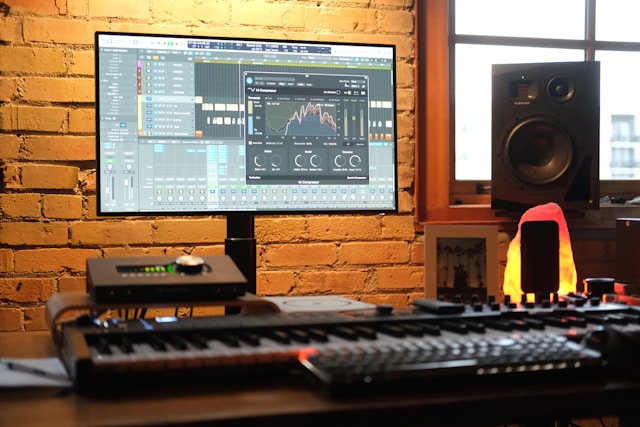
Guide 101: How to Choose the Right Keyboard Controller for Your Needs
Quality music production requires high-end instruments and peripherals. If you love stroking keyboard keys and creating something extraordinary, having a suitable and top-par keyboard controller is a no-brainer. So, how do you choose the right keyboard, and what features should you look for?
Choosing the right keyboard requires understanding how different its components work and how these nuances complete a functional unit. The keyboard controller comes with various parts, technologies, and interfaces that may impact the quality of sound produced and your overall music production experience.
It’s best to wrap your head around what defines an excellent keyboard controller to make your search a breeze. This article will acquaint you with tips to help you pick the keyboard controller suitable for your needs, so please read on to find out more.
What is a Keyboard Controller, and How Does it Work?
A keyboard controller is a device that translates every physical action of pressing keys on a keyboard. These keyboards may have up to 88 key buttons, but a typical tiny MIDI only has about 25. But it’s not just the keys that make up the keyboard; it features various seamlessly interacting parts, including sensors, control elements like knobs, pitch bends, volume controls, a display screen, and connectivity ports.
Once you press a key on a keyboard, the controller activates a sensor beneath it and sends an analog signal to the controller’s internal circuitry. That results in signal processing, converting the analog signal into a digital format, and applying the necessary modifications and adjustments before generating sound. Different components, features, and mechanisms can determine the quality of sound your keyboard controller produces, which should guide you when picking one.
How to Choose the Right Keyboard Controller for Your Needs
It’s easy to get your railroads mixed up if you barely understand what defines the most suitable keyboard controller. A few features to always look for when making this significantly huge decision include the following.
1.Key Action and Count
You’ll have to pick an essential action from various options, which may depend vastly on your preference. A key action is a feature in keyboard controllers that determines this device’s responsiveness to a keystroke. Below are different key action types you should know about:
- Weighted Action: This key action can be ideal for pianists who prefer a more realistic playing experience. It simulates the feel of a traditional acoustic piano with a similar resistance and a more substantial touch.
- Synth Action: This key action is springier in its feel and has a lighter touch. This key action’s expressive bending capability can be ideal if you’re a fast and agile player or love playing scales, preferably an electronic musician or performer.
- Semi-Weighted Action: This key action can be ideal if you prefer a more moderate resistance. It’s also more versatile to suit different playing styles and techniques and is a cut between the weighted keys’ resistance and synth action keys’ feel.
Determining your preferred key action for a more seamless keyboard-playing experience is always prudent. Remember that the key actions above don’t impact your keyboard controller’s sound output but your overall playing experience.
2.Keyboard Connectivity
For the most part, you might want to amplify or modify your sound to output devices when using your keyboard controller. Therefore, please consider your keyboard’s connectivity and compatibility with USBs, MIDI, and other ports. Moreover, you should check your keyboard controller’s wireless connectivity, such as Bluetooth, WiFi, or Radiofrequency.
The more your keyboard controller connects to different output devices or wireless connections, the better it can expand its functionality. That’s essential, especially if you want to amplify or transmit your sounds to MIDI for more modification. Wireless connectivity can also be helpful when you don’t fancy the wires.
3.Keyboard Controls and Knobs
Try considering the types and number of knobs your key-board controller has for a more functional device that expresses your creativity significantly. The most significant real-time parameter adjustments your keyboard controllers shouldn’t miss include the following:
- Knobs: Apart from the conventional volume control and filter cutoff knobs, an ideal key-board controller should have some resonance, ADSR envelope, and modulation depth knobs that enhance your music production experience.
- Sliders: Ensure your key-board has a few sliders, including a modulation wheel, expression, and pitch bends, to allow you to be more expressive and creative in your sound production.
- Quick-Access Buttons: Tap tempo, octave shift, and arpeggiator control buttons add functionality to every key-board controller. Moreover, a transport control to stop, start, and navigate playback in a music software or program change button can add more fun to your craft.
While every music producer and key-board controller enthusiast may have unique music production preferences, it’s best to ensure your device meets the bare minimum.
4.Portability
A key-board controller weighing with the grace of a classic acoustic piano can be tricky because they’re usually hefty. However, lightweight key-board controllers can always do the trick due to their higher portability. There are a few circumstances when key-board controllers’ size and weight matter, so try assessing their suitability.
If you’re a frequent traveler or performer, a bulky key-board controller can only be bothersome and uncomfortable to handle and carry around. However, a home key-board controller, which you’d play without getting outside, can be bulky and sizable. Either way, getting the best size and weight suits you best.
5.Software Integration and technology
Today’s digital age demands more sophisticated key-board controllers that seamlessly integrate with various software. That includes bundled software like effects plugins, digital audio workstations, and virtual instruments. Moreover, it’s best to verify your keyboard controller’s support for MIDI mapping for easy customization of control parameters within your virtual instruments.
6.Keyboard Durability and build quality
Some key-board controllers can be durable, while others are only fickle, breaking down within a few months. So, it’s only natural to wonder what makes a key-board controller durable, which can even be confusing if you need to know how to decide what lasts long. Here’s how to decide whether or not your key-board controller is durable enough:
- Check the keybed construction: The keybed houses the keys and should be made of high-quality reinforced plastic, wood, or metal.
- Key material and coating: The keys may handle more hits and impact as you play your key-board controller, so please ensure they’re synthetic ivory, silicone rubber, or ABS plastic.
- Enclosure: Keyboards with reinforced corners, joints, and seams can be more stable and resistant to damage. That can be handy if you’re more of a traveler or performer.
Understanding the features above regarding your key-board build quality can inform you about its durability, so please pay close attention when choosing your device.
Final Thoughts
The most suitable key-board controller can positively impact your music creation, making it fun and more indulging. Therefore, please put enough thought into the features and components that make your device functional and fun to use. Most key-board controllers from trusted manufacturers come with robust and high-quality builds; all it takes is digging deeper to get what best suits you.
Related
Source: Vietnam Insider
